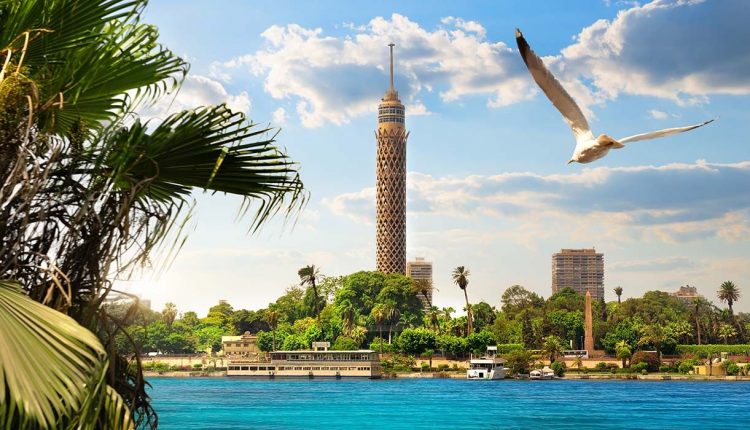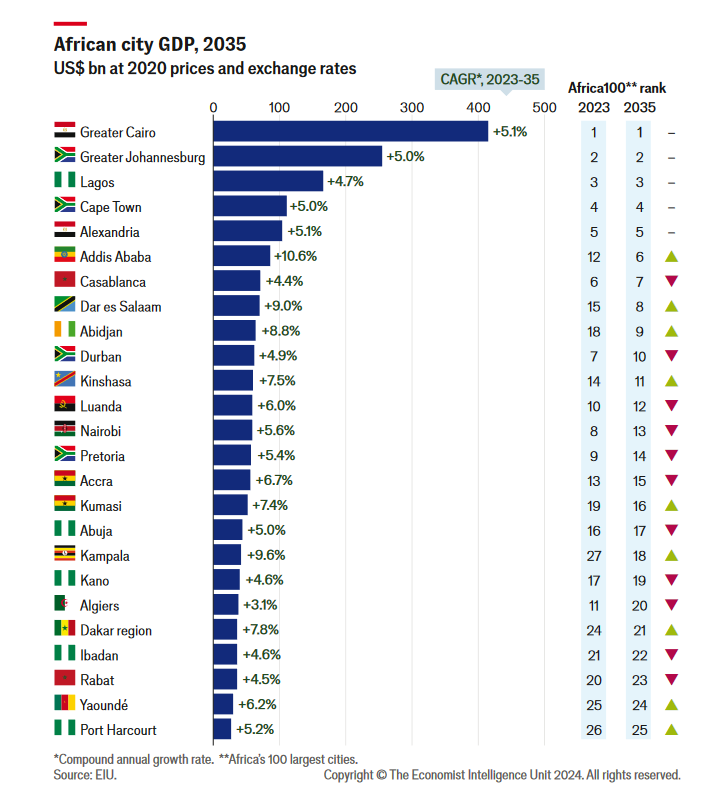Cairo, Alexandria, other African cities to dominate GDP growth by ’35 – EIU
Cairo, Egypt, along with other major African cities, is projected to be among the top 100 African cities with the highest GDP by 2035, according to a recent report by the Economist Intelligence Unit (EIU).
“The largest of the Africa100 city economies—namely Cairo, Johannesburg, Lagos, Cape Town and Alexandria—will grow at a reasonable pace (CAGRs of real GDP measured in 2020 prices and exchange rates of 4-5 per cent in 2023-35) and will retain their position at the top of the city economy rankings in 2035.” EIU report read.
EIU’s Africa100 is dominated by the 20 largest city economies, consisting of the region’s megacities (populations of over 10 million), heavyweights (5-10 million), and fast-moving middleweights. Together, these larger cities will account for almost 70 per cent of Africa100 GDP (measured in 2020 prices and exchange rates) in 2035. They will be major commercial hubs with dynamic and wealthier consumer markets, better connected and more sophisticated commercial and distribution centers, and large bases for industrial production and import-export operations. The largest of the Africa100 city economies—namely Cairo, Johannesburg, Lagos, Cape Town, and Alexandria—will grow at a reasonable pace (CAGRs of real GDP measured in 2020 prices and exchange rates of 4-5 per cent in 2023-35) and will retain their position at the top of the city economy rankings in 2035. Middleweight city economies—including Kinshasa, Luanda, Nairobi, Yaoundé, Douala, Kano, Abuja, Dakar, and Kumasi—will post faster growth (CAGRs of real GDP of 6-8 per cent in 2023-35), but the most dynamic city economies of Dar es Salaam, Addis Ababa, Abidjan, and Kampala will post near or above double-digit CAGRs in 2023-35 and rise rapidly up the city economy rankings.
Moreover, Africa’s top 100 city economies also include cities with a projected population greater than 1 million in 2035 and smaller capitals—such as Libreville, Cotonou, Bissau, Djibouti, Windhoek, Gaborone, and Port Louis. They will be home to almost 400 million people (21 per cent of Africa’s population) yet will generate more than 60 per cent of the continent’s GDP by the mid-2030s. The collective nominal GDP of these cities, measured in current US dollars, is estimated at $1.4 trillion in 2023 and is projected to more than triple to over $5 trillion by 2035. In real terms, these cities are forecast to grow by a CAGR of almost 6 per cent between 2023 and 2035.
The continent’s established urban heavyweights and megacities—including Cairo, Lagos, and Johannesburg—will still sit at the head of the Africa100 city economies in 2035, but middleweight cities (including Kinshasa, Dar es Salaam, Addis Ababa, Abidjan, Kampala, Dakar, and Kumasi) will grow at a much faster pace, supported by infrastructure development, urbanisation, and the emergence of megacities.
The Economist Intelligence Unit expects rapid urbanisation across Africa to help create more dynamic and wealthier consumer markets, better connected and more sophisticated commercial and distribution hubs, and larger bases for industrial production and import-export operations. However, overcrowding, informal settlements, high unemployment, poor public services, stretched utility services, and exposure to climate change are just some of the major challenges that city planners will have to grapple with in their drive for sustainable urban economic growth in the next decade.
Attribution: The Economist Intelligence Unit (EIU)




